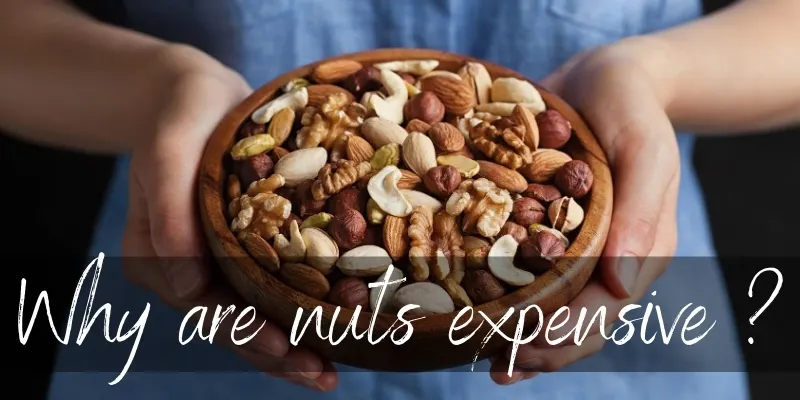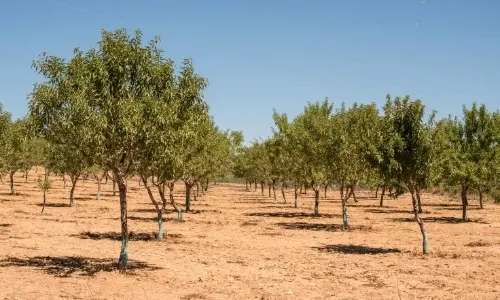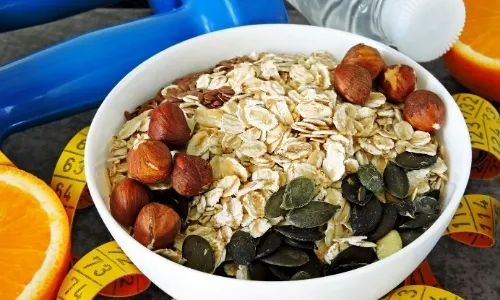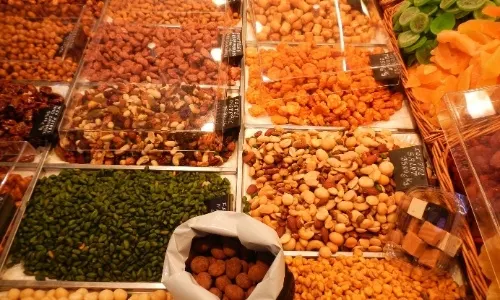Nuts are really great for so many things, from pies to savory foods to stuffings to just snacking on them.
If you’re a nut lover you’ve definitely noticed nuts are pretty expensive. Aside from peanuts, which are easier to grow and aren’t really nuts, regular nuts come at premium prices. Even those that are grown domestically.
This is what we’ve set out to figure out today.

4 reasons nuts are so expensive
You’ve noticed nuts tend to have a higher price compared to other foods, and this is due to a combination of factors.
Hopefully we’ll be able to show you in this article just why they are so expensive, because all of these factors are interlinked.
No one factor is stronger than the other, so the effects ends up being a powerful one that each buyer definitely feels in their pocket.
Read Also:Why Is Almond Milk So Expensive ?
1. Nuts need a specific type of climate
You can’t grow nuts just anywhere. They need a specific climate, because temperature, humidity, and sunshine matter a lot.
As it happens, nuts and many other foods grow best in mild winter areas. In America that’s Zone 9 a and b, as designated by the USDA.
This means that summers are hot, humid and winters are mild. There are cold spikes but crops aren’t heavily damaged.
Nuts grow best in this type of climate, as they grow best during the colder months, except they don’t like very cold areas.
Zone 9 isn’t a very large strip of the planted, as it only has a thin band around the world and most folks plant there.
This leads to not that much land being available, and farmers have to choose between nut trees and other crops when deciding what to grow.

Almond tree plantation
Mild winter areas are also prime real estate
It turns out not only plants and nuts love Zone 9, but also humans. Yes, the great summers and mild winters make the area great real estate and a good portion of farmers sold their lands.
Those lands turned from orchards and plantations to suburban areas, because it turned out to be much more profitable.
So again, the price for a piece of land goes up significantly because you can either build a house, or grow a crop that will bring in less money.
2. Low yield, compared to other crops
Another important point when discussing nuts is that nut trees aren’t like other fruit-bearing trees.
No, nut trees don’t make all that many nuts and not all of them can be used.
Some nuts, like the almond, have only a 66% kernel use. Other kinds of almonds are as low as 32%.
Compared to apples, for example, nut trees yield much less. This will drive up the price.
3. There’s an industry around pollinating nut trees in America
Nut trees are not self pollinating, and they rely on insects to do this for them. The main star here is the lovely honey bee, but there are only so many bees to go around.
In the wild, nut trees are pollinated by bees but the final propagation is slow.
This is why in nut tree crops farmers actually hire bee keepers to bring their bees to the crops. Several bee keepers truck their bees around the entirety of America, and this is a costly service.
If you’re wondering why this should matter for you if you’re not from America, know that most imported nuts are from there.

Bee numbers are dwindling, pollination becomes more expensive
Unfortunately the bee numbers are dwindling all over the planet. But there’s another thing happening that no one can explain properly.
More and more bees are going missing, simply leaving the colony behind.
The queen, larvae, and a few nurses remain within the colony, but the rest of the bees simply disappear.
No dead bees are found around nests and colonies, so it’s like they just vanished.
This phenomenon is called Colony Collapse Disorder, or CCD for short. It’s been looked into for the past century but no clear reasons have been pointed out.
Whatever the reasons, this means that more and more bee keepers are losing their precious bees.
They’re reluctant to rent out their bees for pollination, which drives the pollination service price up, thus driving the final nut price up.
4. Nuts are now considered healthy food
One thing that’s been prevalent in the food industry since the early 2000s is the rise of health foods, and the changing public opinion of what is heath food.
In the 20th century nuts were considered harmful, not good for our health. They contain so much natural fat and oil that they’re bound to have a negative impact on a person’s health.
And that’s kind of true. Excess nut intake will lead to weight gain, the keyword here being excess.

In time researchers have found that the fats in nuts are actually beneficial, especially the omega 3 found in walnuts and the arginine that helps alleviate blood pressure.
Nuts have switched from fatty, unhealthy food to crunchy, healthy snack. This drives up the price, since healthy foods are in higher demand than ever.
The price may only go higher, until a way to produce a higher yield per crop comes along.
Read Also:Almond Milk Substitutes
Why are some nuts more expensive than others ?
All that being said, not all not are the same. As in, all nuts are expensive but some are very expensive.
One such example is the Brazil nut. It grows in pristine forests in South America, meaning those forests that have not been disturbed by humans and still have the few companion trees that can pollinate the Brazil nut tree.
Some specific been types are also necessary for pollination, and harvest from Brazil nut farms is exceptionally low.
The maturing age of the fruit is 14 months, which is amazingly long for a fruit, even a large one as this.
This is a very special nut that will only grow in special conditions, and the price of a pound of Brazil nuts reflects that.
On the other end of the spectrum, almonds seem to be the most affordable nuts on the market. Compared to other nuts, that is.
Where 100 gr of almonds cost about $1.25, pecans can go for $2.25 and pine nuts for $3.97 ! (comparison courtesy of SweetSpotNutrition)

You may wonder why some nuts are more expensive than others. In short, it has to do with how difficult it is to grow those nut trees, and in some cases actually harvesting the nuts can be tricky.
For example pine nuts are manually extracted from pine cones.
On the other hand, cashew shells are poisonous and you will get a severe allergic reaction to touching those shells. Luckily they come both shelled and roasted, which will drive the price up.
In short, nuts of any sort are expensive because they’re harder to grow and harvest. They’re definitely worth the effort though.

